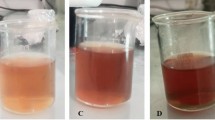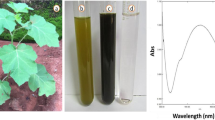Abstract
Biosynthesized silver nanoparticles (Ag-NPs) displayed altogether particular physical, concoction, and natural properties, drawing high consideration for a variety of new applications in different fields due to their cost-effective and eco-friendly procedure. The current work delineates a methodology for the green synthesis of Ag-NPs from the roots of Pueraria Lobata. The Ag-NPs were synthesized at room temperature through a reduction method from the methanolic crude extract of the roots of Pueraria Lobata. UV–vis absorption spectra of Ag-NPs demonstrated the synthesis by giving an intense peak at 248 nm. Transmission electron microscopy (TEM) revealed the synthesis of Ag-NPs was spherical with a size range of 30–60 nm. Fourier transformation infrared spectroscopy (FTIR) results showed the binding properties of bio-constituents responsible for stabilizing the nanoparticles. The synthesis method of Ag-NPs was optimized and the most stable Ag-NPs were achieved after 13 h at pH 9. The in vitro anti-diabetic ability of Ag-NPs was tested against carbohydrate digestion enzyme α-amylase. The result suggests that the Ag-NPs demonstrated remarkable potential of anti-diabetic activity against the key enzyme of diabetes and were found to be appropriate for nano bio-medical application.


Similar content being viewed by others
References
Zhang, X. F., Liu, Z. G., Shen, W., & Gurunathan, S. (2016). Silver nanoparticles: Synthesis, characterization, properties, applications, and therapeutic approaches. International Journal of Molecular Sciences, 17(9), 1534.
Li, W. R., Xie, X. B., Shi, Q. S., Zeng, H. Y., You-Sheng, O. Y., & Chen, Y. B. (2010). Antibacterial activity and mechanism of silver nanoparticles on Escherichia coli. Applied Microbiology and Biotechnology, 85(4), 1115–1122.
Gurunathan, S., Park, J. H., Han, J. W., & Kim, J. H. (2015). Comparative assessment of the apoptotic potential of silver nanoparticles synthesized by Bacillus tequilensis and Calocybe indica in MDA-MB-231 human breast cancer cells: Targeting p53 for anticancer therapy. International Journal of Nanomedicine, 10, 4203.
Li, C., Zhang, Y., Wang, M., Zhang, Y., Chen, G., Li, L., Wu, D., & Wang, Q. (2014). In vivo real-time visualization of tissue blood flow and angiogenesis using Ag2S quantum dots in the NIR-II window. Biomaterials, 35(1), 393–400.
Sondi, I., & Salopek-Sondi, B. (2004). Silver nanoparticles as antimicrobial agent: a case study on E. coli as a model for Gram-negative bacteria. Journal of Colloid and Interface Science, 275(1), 177–182.
Sharma, V. K., Yngard, R. A., & Lin, Y. (2009). Silver nanoparticles: Green synthesis and their antimicrobial activities. Advances in Colloid and Interface Science, 145(1–2), 83–96.
Janakiraman, V., Govindarajan, K., & Magesh, C. R. (2019). Biosynthesis of silver nanoparticles from endophytic fungi, and its cytotoxic activity. BioNanoScience, 9(3), 573–579.
Singh, R., Hano, C., Nath, G., & Sharma, B. (2021). Green biosynthesis of silver nanoparticles using leaf extract of Carissa carandas L. and their antioxidant and antimicrobial activity against human pathogenic bacteria. Biomolecules, 11(2), 299.
Saqib, N. U., & Rahim, M. (2016). Toxicity of silver nanoparticles. Madridge Journal of Nano Technology, 1(1), 1–2.
Kaur, G., Kalia, A., & Sodhi, H. S. (2020). Size controlled, time-efficient biosynthesis of silver nanoparticles from Pleurotus florida using ultra-violet, visible range, and microwave radiations. Inorganic and Nano-Metal Chemistry, 50(1), 35–41.
Azizi, M., Sedaghat, S., Tahvildari, K., Derakhshi, P., & Ghaemi, A. (2020). Green biosynthesis of silver nanoparticles with Eryngium caucasicum Trautv aqueous extract. Inorganic and Nano-Metal Chemistry, 50(6), 429–436.
Otari, S. V., Patil, R. M., Nadaf, N. H., Ghosh, S. J., & Pawar, S. H. (2012). Green biosynthesis of silver nanoparticles from an actinobacteria Rhodococcus sp. Materials Letters, 72, 92–94.
Mittal, A. K., Chisti, Y., & Banerjee, U. C. (2013). Synthesis of metallic nanoparticles using plant extracts. Biotechnology Advances, 31(2), 346–356.
Shrivastava, S., & Leelavathi, S. (2010). Preliminary phytochemical evaluation of leaf extracts of Catunaregum spinosa Thumb. International Journal of Pharmaceutical Sciences Review and research, 3(2), 114–118.
Carter, G. A., & Teramura, A. H. (1988). Vine photosynthesis and relationships to climbing mechanics in a forest understory. American Journal of Botany, 75(7), 1011–1018.
Hu, H. T., Fen, F., & Ding, M. P. (2008). Effects of puerarin with aspirin on the markers of damaged vascular endothelial cells in patients with acute cerebral infarction. Zhongguo Zhong Yao Za Zhi= Zhongguo Zhongyao Zazhi= China Journal of Chinese Materia Medica, 33(23), 2827–2829.
Ren, P., Hu, H., & Zhang, R. (2000). Observation on efficacy of puerarin in treating diabetic retinopathy. Zhongguo Zhong Xi Yi Jie He Za Zhi Zhongguo Zhongxiyi Jiehe Zazhi= Chinese Journal of Integrated Traditional and Western Medicine, 20(8), 574–576.
Wu, K., Liang, T., Duan, X., Xu, L., Zhang, K., & Li, R. (2013). Anti-diabetic effects of puerarin, isolated from Pueraria lobata (Willd.), on streptozotocin-diabetogenic mice through promoting insulin expression and ameliorating metabolic function. Food and chemical toxicology, 60, 341–347.
Long, A. N., & Dagogo-Jack, S. (2011). Comorbidities of diabetes and hypertension: Mechanisms and approach to target organ protection. The Journal of Clinical Hypertension, 13(4), 244–251.
Newton, C. A., & Raskin, P. (2004). Diabetic ketoacidosis in type 1 and type 2 diabetes mellitus: Clinical and biochemical differences. Archives of Internal Medicine, 164(17), 1925–1931.
Talchai, C., Xuan, S., Lin, H. V., Sussel, L., & Accili, D. (2012). Pancreatic β cell dedifferentiation as a mechanism of diabetic β cell failure. Cell, 150(6), 1223–1234.
McCue, P. P., & Shetty, K. (2004). Inhibitory effects of rosmarinic acid extracts on porcine pancreatic amylase in vitro. Asia Pacific Journal of Clinical Nutrition, 13(1), 101–106.
Ihsan, M., Niaz, A., Rahim, A., Zaman, M. I., Arain, M. B., Sharif, T., & Najeeb, M. (2015). Biologically synthesized silver nanoparticle-based colorimetric sensor for the selective detection of Zn 2+. RSC advances, 5(111), 91158–91165.
Eichler, H. G., Korn, A., Gasic, S., Pirson, W., & Businger, J. (1984). The effect of a new specific α-amylase inhibitor on post-prandial glucose and insulin excursions in normal subjects and type 2 (non-insulin-dependent) diabetic patients. Diabetologia, 26(4), 278–281.
Justino, A. B., Miranda, N. C., Franco, R. R., Martins, M. M., da Silva, N. M., & Espindola, F. S. (2018). Annona muricata Linn. leaf as a source of antioxidant compounds with in vitro antidiabetic and inhibitory potential against α-amylase, α-glucosidase, lipase, non-enzymatic glycation and lipid peroxidation. Biomedicine & Pharmacotherapy, 100, 83–92.
Funding
This study received financial support from the Department of Chemistry, Zhejiang University, Hangzhou, and the Department of Chemistry, University of Science and Technology Bannu.
Author information
Authors and Affiliations
Corresponding authors
Ethics declarations
Informed Consent
The research did not involve human subjects or personal information. No, informed consent is required.
Research Involving Human Participants and/or Animals
None.
Conflict of Interest
The authors declare no competing interests.
Additional information
Publisher's Note
Springer Nature remains neutral with regard to jurisdictional claims in published maps and institutional affiliations.
Rights and permissions
About this article
Cite this article
Inam, M., Shah, A., Khan, W.N. et al. Biosynthesis of Silver Nanoparticles: Preparation, Optimization and In Vitro Anti-diabetic Effect. BioNanoSci. 11, 1154–1159 (2021). https://doi.org/10.1007/s12668-021-00895-6
Accepted:
Published:
Issue Date:
DOI: https://doi.org/10.1007/s12668-021-00895-6




